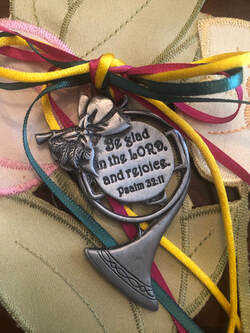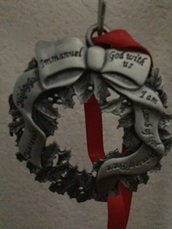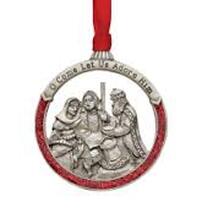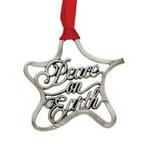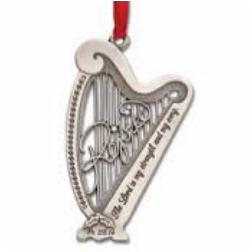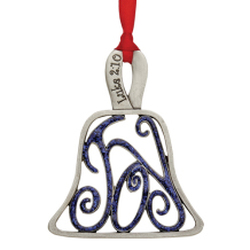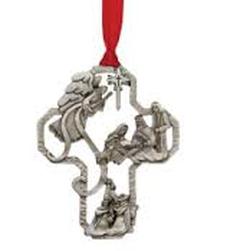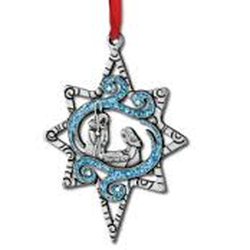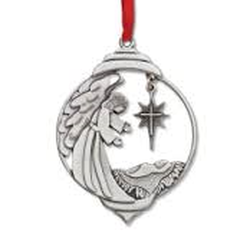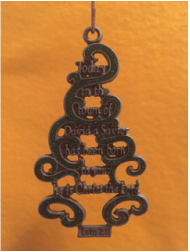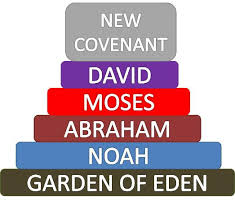CTA Ornaments
(Christ to All)
The most striking thing about CTA Ornaments is that they are just what they say they are - overt and explicit tools of the Christian faith. I have given many, many of these lovely ornaments away to my volunteers and teachers, or as tokens at retreats. Sometimes, I've included a meditation on the ornaments as part of a workshop, or in a Thank You card I send. They are like pointers to a richer, fuller truth that should be uncovered. The Scriptural quote just shows the way. Read below to see what I mean.
For more information on CTA or to buy the ornaments go here: www.ctainc.com The Ornaments of Faith are in alphabetical order.
For more information on CTA or to buy the ornaments go here: www.ctainc.com The Ornaments of Faith are in alphabetical order.
|
|
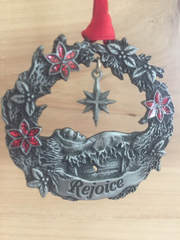
A Reason to Rejoice
Ornament of Faith The God of hope fill you with all joy and peace in believing. Romans 15:13 This ornament features the baby Jesus lying snuggly tucked into a wreath decorated with 3 bright red poinsettias, gazing at the Christmas Star. The poinsettias are especially significant, because this ornament is an unspoken image of the Trinity. The 3 red flowers, star shaped and the only bits of color, are arranged in a triangle, symbolize the eternal pattern of the Father, Son and Holy Spirit. We often speak of how the Son offered his life back to the Father, in atonement for the sins of mankind, and to re-establish a right relationship with God. But we don't often talk about how salvation was an action of all 3 members of the Trinity. God the Father did not insist that Jesus go and "clean up" the mess that we made, as though it were just a Plan B after the fall of Paradise. On the contrary, many mystics have testified to the fact that this was part of the plan from the beginning. The Trinity already saw that any creation, no matter how great, would find it enormously difficult to maintain its innocence, not due necessarily to a defect but simply because it is not "the immovable, eternal one." Only by participating in the very inner life of the Trinity, who IS and GIVES life, can we actually stop falling apart. We just don't have the capacity to do that on our own. It's not part of our nature. As Jesus said to St. Catherine of Siena "Do you know who you are, dearest daughter? You are who is not, while I AM who is." This ornament reminds us of the overwhelming, overflowing (symbolized by the bright red, star-flowers) love of the Trinity that results in the the saving work of Christ, as an action of the whole Trinity. The birth of Christ was truly a reason to rejoice, and be "filled with all joy and peace," but only for those who believe. If you don't believe in the need to be lifted up, helped and grafted onto someone stronger and better, none of this makes any sense. The mystery of the birth of Christ, revealed to the most humble of the time - the shepherds and the outcasts - only brought hope and peace to those who were well aware of their own lack. A lack of ability to find meaning in life. A lack of influence. A lack of importance. A lack of safety. A lack of even the most basic material possessions. A lack of ability to improve their lot, spiritually and physically. The great news this ornament portrays is the news that ultimately, the expectation to fix, to save, to redeem ourselves and our lot, is not considered our job. The Trinity takes upon themselves this work, the work of salvation. All we are asked to do is participate in it, and to believe. To borrow the expression from The Polar Express, the bell will still ring for you, you will still hear and understand, as will all "who truly believe." 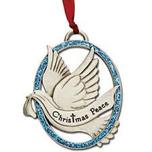
Christmas Peace
Ornament of Faith The Lord of Peace Himself give you Peace Always! 2 Thess. 3:16 It's somewhat ironic that this oft quoted and popular Scripture verse comes at the end of Paul's Second Letter to the Thessalonians, wherein he has just finished admonishing the young church to turn from all the internal strife going on. Clearly, the Thessalonians are having trouble getting along. It seems that there are a few people in the church who are not doing their part and Paul says forcefully that "if they don't work, then they can't eat." He further says, "some are conducting themselves among you in a disorderly way, by not keeping busy but minding the business of others." Paul tells them to try to correct those who are not living charitably, even to the point of not associating with them anymore, but to refrain nevertheless from treating them as enemies. Lack of peace is a theme that we see over and over in Scripture, and it's certainly one we can all relate to, not just in the world at large but also in our own personal lives. This ornament does a good job of recalling the various times in Scripture when peace is offered. The dove, as the symbol of the Holy Spirit, first moves over the waters (represented by the band of blue around the ornament) during the creation story when "a mighty wind moved over the waters." The Hebrew translation for "wind" here is "spirit or breath [ruah] of God." As the creation story relates, after the spirit of God was finished moving, the chaos and formlessness of the pre-creation world had gone. It had been replaced with order, peace, and beauty and was therefore proclaimed "good." The same "wind" of God is next seen in the story of Noah. Genesis 8:1 states "God remembered Noah and all the animals, wild and tame, that were with him in the ark. So God made a wind sweep over the earth, and the waters began to subside." The Spirit of God is again recreating the world after the flood, beginning again with Noah and his family, instituting peace and order. Then later, in the Gospel of Mark, we see the same theme. Jesus has just been baptized by John when "coming up out of the water, the heavens open and the Spirit, like a dove, descending upon Jesus." The meaning here is obvious - Jesus will create a new world, the Kingdom of God, and a new people, the people of God, through baptism and the Holy Spirit. It's the same theme already shown in creation and with Noah. Finally, the Gospel of John relates that when Jesus appears to the disciples after his resurrection he says " Peace be with you. As the Father has sent me, so I send you. And when he had said this, he breathed on them and said to them, "Receive the Holy Spirit." Jesus has completed the work he has come to do. He gives the disciples his peace, the breath of God that brings peace and harmony out of chaos and fear, so that they can receive what is his, and also give it to others. In his Letter to the Thessalonians, Paul picks up on this theme. He invokes the peace of Christ, the breath of God, to be with them so that the internal squabbles and peacelessness with each other may be resolved and the community may be transformed. Would that we may each experience that same Breath of God! 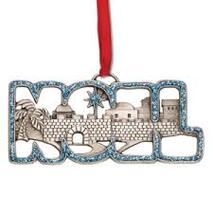
Come to Bethlehem and See!
Ornament of Faith Let us go the Bethlehem and see this thing that has happened, which the Lord has made known to us. Luke 2:15 This is another beautifully creative ornament from CTA. The Bethlehem village image inserted into the word NOEL immediately gets the imagination going, conjuring up images of calm nights, bright stars, palm trees, sand and that deep, dusty, earthy feeling of bricks. It also reminds us of prophesies fulfilled, a world on the move, and salvation history clearly culminating in Christ's birth and death. We see the word NOEL around all the time at Christmas, and don't even think about it twice. But what does the word "NOEL" even mean? Here's a good explanation from gotquestions.org: www.gotquestions.org: Every year, people sing songs like “The First Noel” at Christmas, and many wonder what a “noel” is. In French, joyeux noel means “Merry Christmas.” Our modern English word comes from the Middle English nowel, which Webster’s 1828 Dictionary defined as “a shout of joy or Christmas song.” The roots of the word are the French noel (“Christmas season”), which may come from the Old French nael. This, in turn, is derived from the Latin natalis, meaning “birth.” Since Christmas is the celebration of the birth of Christ, it was natural for people to refer to the celebration as the “nativity” or the “birth.” Another possible root for noel, also from the French, is the word nouvelles, meaning “news.” As the popular carol says, “The first noel the angels did say / Was to certain poor shepherds. . . .” The meaning of “news” certainly makes sense in that context; however, the early usage and definition of noel seem to focus more on the idea of birth, and that is probably the more accurate meaning. There are very few records giving the details of the earliest Christmas practices, but at least as early as the 4th century, some Christian groups were celebrating natus Christus on December 25. Since their almanac referred to the day as “the birth of Christ,” it would be natural to see derivative words like nael and noel used in the same way. In the Middle Ages, several English carols began with nowell, and French carols similarly used noel. Since early songs often used the first word as the title, a “noel” came to refer to any song about the birth of Christ. Because of this, the word now carries the dual meaning of a Christmas song and the Christmas celebration itself. Our English carol “The First Noel” was first published in a book titled Carols Ancient and Modern, edited by William Sandys in 1823. The message of the song is the joyous pronouncement that the King of Israel has been born. When we sing the song or wish someone a joyous noel, we are following the example of the angels, announcing the good news that Jesus Christ was born, not just for Israel, but for all mankind, so we could receive forgiveness of sins through Him. One last thought. Maybe the greatest reason for crying "NOEL!" is that through the miracle of the Eucharist, we, thousands of years later, are still able to go to the Bethlehem, translated "the House of Bread," and encounter the same Christ, the "bread come down from heaven." Now that's "news" worth a "shout of joy!" May we all continue to "go to Bethlehem and see this thing that the Lord has made known to us." |
|
|
Each covenant builds on the one before it, becoming more focused and more revelatory of God, until finally God himself is revealed in Jesus, the culmination of creation and history, in the New Covenant at the top. The Scripture proclaims that it is "today!" that the savior has been born. While this scripture quote does indeed anchor the birth of Jesus to a very specific time (roughly 4AD) and place (Bethlehem, the town of David) it is also proclaiming that same message to us today, thousands of years later.
Through Scripture and Tradition, Jesus can be born again in our hearts and as bread - the Eucharist. Still today, we see that the New Covenant fulfills and carries on all the promises that came before it. We are made into a new creation (fulfilling the Garden of Eden covenant), in Baptism we are carried in the "bark of Peter" through death to new life (fulfilling the covenant with Noah), we receive the promise of becoming a new race of people and a savior who would sacrifice himself for us (the Abrahamic covenant), we participate in a saving meal and are rescued from slavery (the Mosaic covenant), and we are given rest from our "enemies round about," even the last enemy - death (the Davidic covenant). This basic premise of promises fulfilled is written into the form of the Christmas tree, making it such a wonderfully appropriate symbol of Christmas, if we see it through the eyes of faith. |

